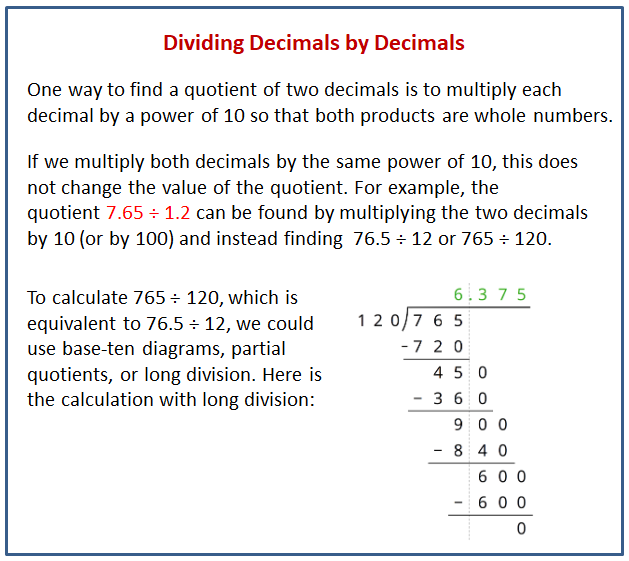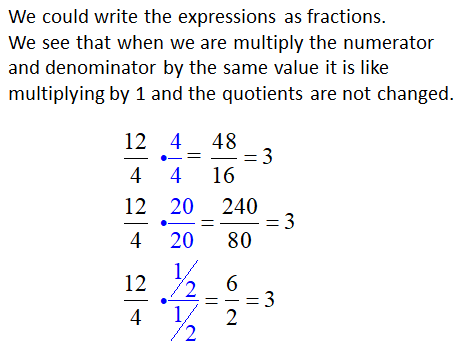Illustrative Mathematics Unit 6.5, Lesson 13: Dividing Decimals by Decimals
Learning Targets:
- I can explain how multiplying dividend and divisor by the same power of 10 can help me find a quotient of two decimals.
- I can find the quotient of two decimals.
Related Pages
Illustrative Math
Grade 6
Lesson 13: Dividing Decimals by Decimals
Let’s divide decimals by decimals.
Illustrative Math Unit 6.5, Lesson 13 (printable worksheets)
Lesson 13 Summary
One way to find a quotient of two decimals is to multiply each decimal by a power of 10 so that both products are whole numbers.
The following diagram gives an example of how to divide a decimal by a decimal.

Lesson 13.1 Same Values
- Use long division to find the value of
5.04 ÷ 7 - Which of the following quotients has the same value as 5.04 ÷ 7? Be prepared to explain how you know.
A. 5.04 ÷ 70
B. 50.4 ÷ 70
C. 504,000 ÷ 700
D. 504,000 ÷ 700,000
Lesson 13.2 Placing Decimal Points in Quotients
- Think of one or more ways to find 3 ÷ 0.12. Show your reasoning.
- Find 1.8 ÷ 0.04. Show your reasoning. If you get stuck, think about what equivalent division expression you could write to help you divide.
- Diego said, “To divide decimals, we can start by moving the decimal point in both the dividend and divisor by the same number of places and in the same direction. Then we find the quotient of the resulting numbers.”
Do you agree with Diego’s statement? Use the division expression 7.5 ÷ 1.25 to support your answer.
Are you ready for more?
Can we create an equivalent division expression by multiplying both the dividend and divisor by a number that is not a multiple of 10 (for example: 4, 20, or ½)? Would doing so produce the same quotient? Explain or show your reasoning.
-
Show Answer
Yes, they would all produce the same quotient. For example, the expressions 48 ÷ 16, 240 ÷ 80, 6 ÷ 2 are equivalent to 12 ÷ 4 because they all have a quotient of 3.

Lesson 13.3 Practicing Division with Decimals
- Here are two calculations of 48.78 ÷ 9. Work with your partner to answer the following questions.
b. Look at Calculation A. Explain how you can tell that the 36 means “36 tenths” and the 18 means “18 hundredths.”
c. Look at Calculation B. What do the 3600 and 1800 mean?
d. We can think of 48.78 ÷ 9 = 5.42 as saying “there are 9 groups of 5.42 in 48.78.” We can think of 4878 ÷ 900 = 5.42 as saying “there are 900 groups of 5.42 in 4878.” How might we show that both statements are true? - a. Explain why 51.2 ÷ 6.4 has the same value as 5.12 ÷ 0.64.
b. Write a division expression that has the same value as 51.2 ÷ 6.4 but is easier to use to find the value. Then, find the value using long division.
Lesson 13.4 Two Ways to Calculate Quotients of Decimals
Find each quotient using a method of your choice. Then discuss your calculations with your group and agree on the correct answers. If someone in your group makes an error, stop and help that person revise their work. If your group is unsure about an answer, consult your teacher.
- 106.5 ÷ 3
- 58.8 ÷ 0.7
- 257.4 ÷ 1.1
- Mai is making friendship bracelets. Each bracelet is made from 24.3 cm of string. If she has 170.1 cm of string, how many bracelets can she make? Explain or show your reasoning.
Lesson 13 Practice Problems
- A student said, “To find the value of 109.2 ÷ 6, I can divide 1,092 by 60.”
a. Do you agree with this statement? Explain your reasoning.
b. Calculate the quotient of 109.2 ÷ 6 using any method of your choice. - Here is how Han found 31.59 ÷13:
a. At the second step, Han subtracts 52 from 55. How do you know that these numbers represent tenths?
b. At the third step, Han subtracts 39 from 39. How do you know that these numbers represent hundredths?
c. Check that Han’s answer is correct by calculating the product of 2.43 and 13. - a. Write two division expressions that have the same value as 61.12 ÷ 3.2.
b. Find the value of 61.12 ÷ 3.2. Show your reasoning. - A bag of pennies weighs 5.1 kilogram. Each penny weighs 2.5 grams. About how many pennies are in the bag?
A. 20
B. 200
C. 2,000
D. 20,000 - Find each difference. If you get stuck, consider drawing a diagram.
a. 2.5 - 1.6
b. 0.72 - 0.4
c. 11.3 - 1.75
d. 73 - 1.3 - Plant B is 6 2/3 inches tall. Plant C is 4 4/15 inches tall. Complete the sentences and show your reasoning.
a. Plant C is _______ times as tall as Plant B.
b. Plant C is _______ inches ____________ (taller or shorter) than Plant B. - At a school, 460 of the students walk to school.
a. The number of students who take public transit is 20% of the number of students who walk. How many students take public transit?
b. The number of students who bike to school is 5% of the number of students who walk. How many students bike to school?
c. The number of students who ride the school bus is 110% of the number of students who walk. How many students ride the school bus?
The Open Up Resources math curriculum is free to download from the Open Up Resources website and is also available from Illustrative Mathematics.
Try out our new and fun Fraction Concoction Game.
Add and subtract fractions to make exciting fraction concoctions following a recipe. There are four levels of difficulty: Easy, medium, hard and insane. Practice the basics of fraction addition and subtraction or challenge yourself with the insane level.

We welcome your feedback, comments and questions about this site or page. Please submit your feedback or enquiries via our Feedback page.
